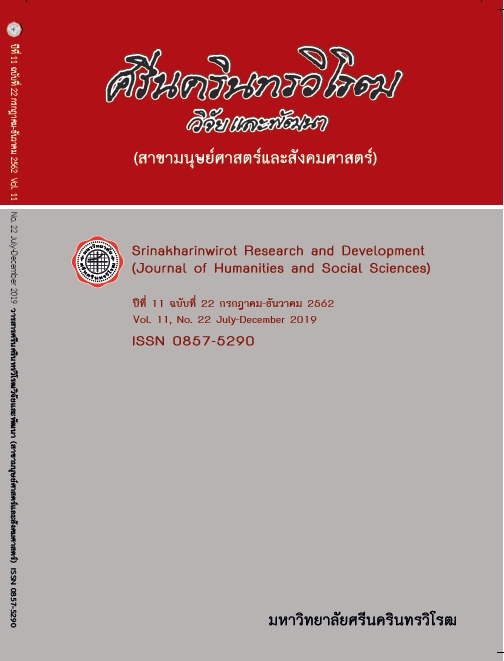การมีบุตรคนแรกช้าของสตรีสมรสในประเทศไทย : สถานการณ์ แนวโน้ม และปัจจัยกำหนด (STEM LEARNING APPROACH AND PROBLEM SOLVING USING THE 4WP FORMAT FOR MATHAYOMSUKSA III STUDENTS, PATUMWAN DEMONSTATION SCHOOL, SRINAKHARINWIROT UNIVERSITY)
คำสำคัญ:
อายุเมื่อมีบุตรคนแรก, อายุเมื่อมีบุตรคนแรกช้า, ภาวะเจริญพันธุ์ระดับต่ำ, สตรีสมรสบทคัดย่อ
การศึกษาครั้งนี้มีวัตถุประสงค์เพื่อ 1) นำเสนอสถานการณ์และแนวโน้มของอายุเมื่อมีบุตรคนแรก โดยใช้ข้อมูลการสำรวจระดับประเทศที่มีกลุ่มตัวอย่างเป็นสตรีวัยเจริญพันธุ์อายุระหว่าง 15-49 ปี จำนวน 4 โครงการ ระหว่างปี พ.ศ. 2544-2559 และ 2) ศึกษาความสัมพันธ์ระหว่างปัจจัยด้านประชากร เศรษฐกิจสังคม และอนามัยเจริญพันธุ์
กับการมีบุตรคนแรกช้า โดยในการศึกษาความสัมพันธ์ได้ประยุกต์ใช้รูปแบบเชิงสาเหตุของอายุเมื่อมีบุตรคนแรก (Causal Model of Age at First Birth) ของ Rindfuss และ St. John ในปี ค.ศ. 1983 และใช้ข้อมูลเชิงปริมาณจากการสำรวจระดับประเทศของโครงการการเปลี่ยนแปลงทางประชากรและความอยู่ดีมีสุขในบริบทสังคมสูงวัย พ.ศ. 2559 ของวิทยาลัยประชากรศาสตร์ จุฬาลงกรณ์มหาวิทยาลัย มีประชากรตัวอย่างคือสตรีวัยเจริญพันธุ์อายุ 15-49 ปี โดยการศึกษาครั้งนี้คัดเลือกเฉพาะสตรีสมรสอายุระหว่าง 30-49 ปี ที่มีบุตรเกิดมีชีพอย่างน้อย 1 คน และมีข้อมูลสำหรับการวิเคราะห์ครบถ้วน (N = 4,324) การวิเคราะห์ข้อมูลใช้สมการถดถอยโลจิสติกแบบทวิภาค (Logistic Regression Analysis) โดยตัวแปรตามคืออายุเมื่อมีบุตรคนแรกช้าของสตรี แปลงค่าให้เป็นตัวแปรหุ่น โดย 0 แสดงอายุสตรีที่มีบุตรคนแรกก่อนอายุ 29 ปี และ 1 แสดงตรงกันข้าม ผลการศึกษาสถานการณ์และแนวโน้มของอายุเมื่อมีบุตรคนแรกของสตรีสมรสในประเทศไทย พบว่าในปัจจุบันสตรีมีอายุเฉลี่ยเมื่อมีบุตรคนแรกอยู่ที่ 23.5 ปี และแนวโน้มของอายุเมื่อมีบุตรคนแรกมีลักษณะคงที่ในช่วงระยะเวลา 15 ปีที่ผ่านมา อย่างไรก็ตามสัดส่วนของสตรีที่มีบุตรคนแรกเมื่ออายุ 30 ปี หรือมากกว่า เพิ่มขึ้นจากร้อยละ 10.4 ในปี พ.ศ. 2544 เป็นร้อยละ 14.5 ในปัจจุบัน ในส่วนของผลการวิเคราะห์ปัจจัยที่มีความสัมพันธ์กับการมีบุตรคนแรกช้า พบว่า ภายหลังการควบคุมอิทธิพลจากปัจจัยทั้งหมด ปัจจัยด้านประชากร ได้แก่ อายุของสตรี อายุแรกสมรส และจำนวนบุตรที่ต้องการ สามารถอธิบายการมีบุตรคนแรกช้าได้ดีที่สุด นอกจากนี้ปัจจัยด้านเศรษฐกิจสังคม ในตัวแปรระดับการศึกษา มีความสัมพันธ์อย่างมีนัยสำคัญกับการมีบุตรคนแรกช้า และสามารถอธิบายความสัมพันธ์ดังกล่าวได้ดีเช่นกัน รวมไปถึงปัจจัยด้านอนามัยเจริญพันธุ์ ได้แก่ ข้อจำกัดของความสามารถในการมีบุตร และภาวะมีบุตรยาก ที่มีอิทธิพลต่อการมีบุตรคนแรกช้า ซึ่งแสดงถึงความสำคัญทางกระบวนการทางชีววิทยาที่ส่งผลต่ออายุเมื่อมีบุตรคนแรก ในขณะที่ตัวแปรด้านการทำงานของสตรีสามารถอธิบายการมีบุตรคนแรกช้าได้น้อยที่สุด
Downloads
เอกสารอ้างอิง
[2] ปราโมทย์ ประสาทกุล, และปัทมา ว่าพัฒนวงศ์. (2554). จุดเปลี่ยนประชากรไทย. ใน สุรีย์พร พันพึ่ง และมาลี
สันภูวรรณ์. จุดเปลี่ยนประชากร จุดเปลี่ยนสังคมไทย. 13-22. กรุงเทพฯ: สำนักพิมพ์ประชากรและสังคม.
[3] Lesthaeghe, R., & Van de Kaa, D. J. (1986). Two demographic transitions? In D.J. Van de Kaa and Ronald Lesthaeghe (Eds), Population Growth and Decline, 9-24. Deventer: Van Loghum.
[4] Lesthaeghe, R. (2010). The unfolding story of the second demographic transition. Population and Development Review. 36(2), 211-251.
[5] Van de Kaa, D. J. (2003). Demographies in Transition: an Essay on Continuity and Discontinuity in Value Change, in E. Kotowska and J. Jozwiak (Eds.), Population of Central and Eastern Europe. Challenges and Opportunities, 641-643. Warsaw: Statistical Publishing Establishment.
[6] Putnam, R.D. (2000). Bowling alone: America’s declining social capital, in Culture and politics. pp. 223-234. Springer.
[7] United Nations, Department of Economic and Social Affairs, Population Division. (2013). World Population Prospects: The 2013 Revision. n.p.
[8] Billari, F.C., et al. (2007). Approaching the Limit: Long‐Term Trends in Late and Very Late Fertility. Population and Development Review. 33(1), 149-170.
[9] Frejka, T. and G. Calot. (2001). Cohort Reproductive Patterns in Low‐Fertility Countries. Population and Development Review. 27(1), 103-132.
[10] Lesthaeghe, R. (2001). Postponement and recuperation: Recent fertility trends and forecasts in six Western European Countries. Interface Demography, Vrje Universiteit, Brussels, Belgium. Retrieved from http://www.vub.ac.be/soco/index.htm
[11] Hardy, J.B., et al. (1998). Like mother, like child: intergenerational patterns of age at first birth and associations with childhood and adolescent characteristics and adult outcomes in the second generation. Developmental Psychology. 34(6), 1220.
[12] Fergusson, D.M. and L.J. Woodward. (1999). Maternal age and educational and psychosocial outcomes in early adulthood. Journal of Child Psychology and Psychiatry. 40(3), 479-489.
[13] Bianco, A., et al. (1996). Pregnancy outcome at age 40 and older. Obstetrics & Gynecology. 87(6), 917-922.
[14] Gilbert, W.M., T.S. Nesbitt, and B. Danielsen. (1999). Childbearing beyond age 40: pregnancy outcome in 24,032 cases. Obstetrics & Gynecology. 93(1), 9-14.
[15] Jolly, M., et al. (2000). The risks associated with pregnancy in women aged 35 years or older. Human reproduction. 15(11), 2433-2437.
[16] Tough, S.C., et al. (2002). Delayed childbearing and its impact on population rate changes in lower birth weight, multiple birth, and preterm delivery. Pediatrics. 109(3), 399-403.
[17] Ziadeh, S. and A. Yahaya. (2001). Pregnancy outcome at age 40 and older. Archives of gynecology and obstetrics. 265(1), 30-33.
[18] Copper, R.L., et al. (1993). A multicenter study of preterm birth weight and gestational age—specific neonatal mortality. American Journal of Obstetrics & Gynecology. 168(1), 78-84.
[19] Kramer, M.S. (1987). Determinants of low birth weight: methodological assessment and meta-analysis. Bulletin of the world health organization. 65(5), 663.
[20] McCormick, M.C. (1985). The contribution of low birth weight to infant mortality and childhood morbidity, New England Journal of Medicine. 312(2), 82-90.
[21] McCormick, M.C., et al. (1992). The Health and Developmental Status of Very Low-Birth-Weight Children at School Age. Jama. 267(16), 2204-2208.
[22] Rindfuss, R.R. and C. St. John. (1983). Social determinants of age at first birth. Journal of Marriage and the Family. 553-565.
[23] Hakim, C. (2001). Work-lifestyle choices in the 21st century: Preference theory. Oxford: Oxford University Press.
[24] Heckman, J.J. and Walker, J.R. (1990). The relationship between wages and income and the timing and spacing of births: evidence from Swedish longitudinal data. Journal of the Econometric Society. 1411-1441.
[25] Tasiran, A.C. (1995). Fertility dynamics: Spacing and timing of births in Sweden and the United States. Amsterdam: Elsevier.
[26] Settersten Jr, R.A. and K.U. Mayer. (1997). The measurement of age, age structuring, and the life course. Annual review of sociology. 23(1), 233-261.
[27] Hahs-Vaughn, D.L. (2005). A primer for using and understanding weights with national datasets. The Journal of Experimental Education. 73(3), 221-248.
[28] Duncan, O.D. and A.J. Reiss. (1956). Social characteristics of urban and rural communities: 1950. New York: Wiley.
[29] Prioux, F. (2005). Late fertility in Europe: some comparative and historical data. Revue d'épidémiologie et de santé publique. 53, 3-11.
[30] Kohler, H.P., F.C. Billari, and J.A. Ortega. (2002). The emergence of lowest-low fertility in Europe during the 1990s. Population and development review. 28(4), 641-680.
[31] Gustafsson, S. and C., Wetzels. (2000). Optimal age at first birth: Germany, Great Britain, the Netherlands and Sweden", in Gustafsson S. and Meulders D.E., Gender and the Labour Market, London: MacMillan.
[32] Castiglioni, M., Dalla Zuanna, G., and Loghi, M. (2001). Planned and unplanned births and conceptions in Italy. European Journal of Population. 17(3), 207-233.
[33] Liefbroer, A.C. (1999). From youth to adulthood: Understanding changing patterns of family formation from a life course perspective, in Population Issues, pp. 53-85. Dordrecht: Springer.
[34] Cigno, A. (1991). Economics of the family. Oxford: Oxford University Press.
[35] Walker, J.R. (1995). The effect of public policies on recent Swedish fertility behavior. Journal of population economics. 8(3), 223-251.
ดาวน์โหลด
เผยแพร่แล้ว
รูปแบบการอ้างอิง
ฉบับ
ประเภทบทความ
สัญญาอนุญาต
วารสารศรีนครินทรวิโรฒวิจัยและพัฒนา สาขามนุษยศาสตร์และสังคมศาสตร์ อยู่ภายใต้การอนุญาต Creative Commons Attribution-NonCommercial-NoDerivs 4.0 International (CC-BY-NC-ND 4.0) เว้นแต่จะระบุไว้เป็นอย่างอื่น โปรดอ่านหน้านโยบายของวารสารสำหรับข้อมูลเพิ่มเติมเกี่ยวกับการเข้าถึงแบบเปิด ลิขสิทธิ์ และการอนุญาต



